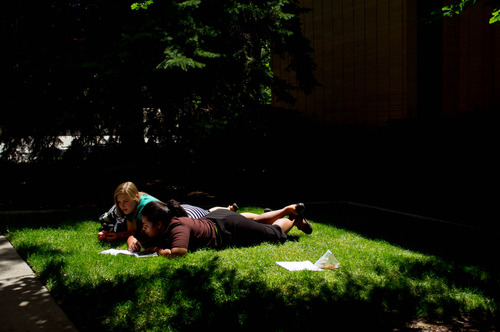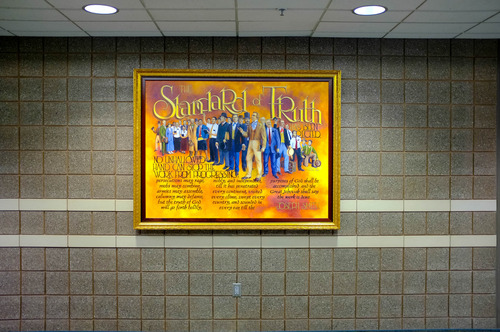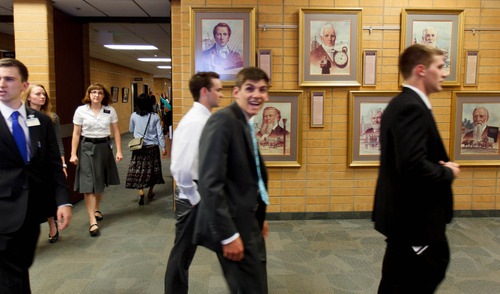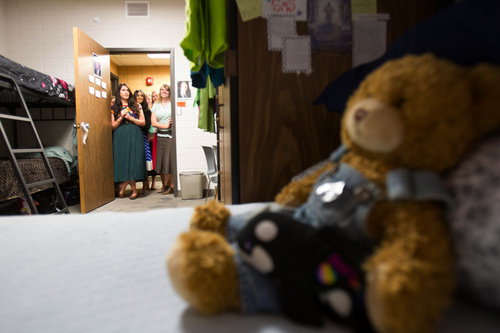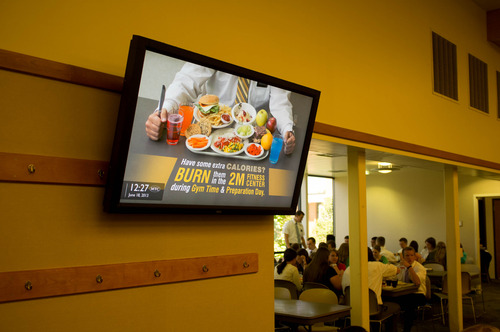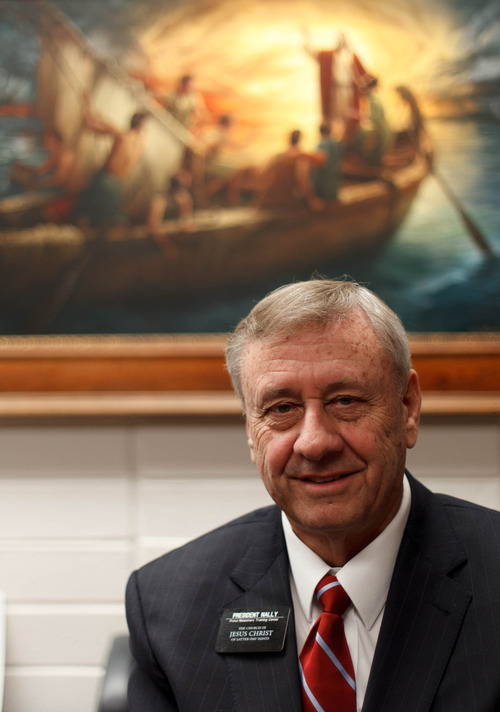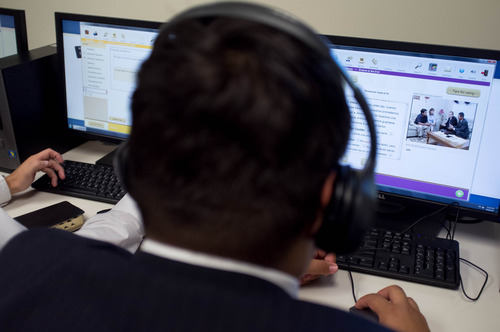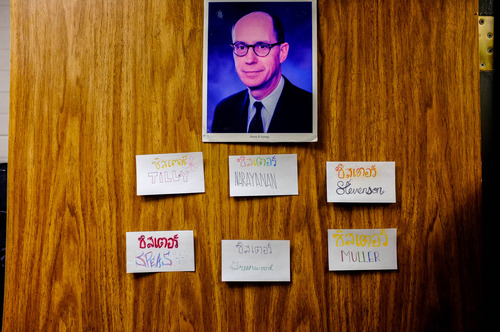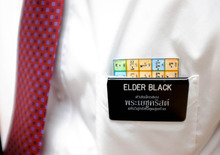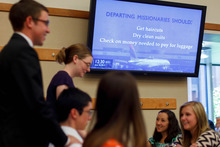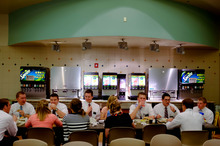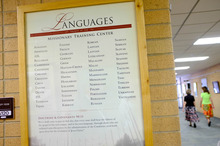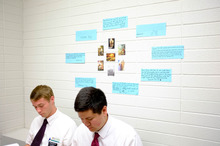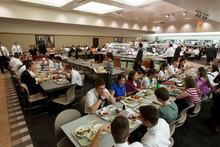This is an archived article that was published on sltrib.com in 2013, and information in the article may be outdated. It is provided only for personal research purposes and may not be reprinted.
Provo • The 35-acre campus is an island of young people, where teens and 20-somethings outnumber grown-ups by 10-to-1.
Sure, the place is awash in fresh-faced students, but even the workers — from the cafeteria to the copy center, the mailroom to the bookstore — and most of the teachers are under 30.
It's no "Animal House," though, with raucous frats, food fights and binge drinking. This is Mormonism's premier Missionary Training Center, where the men wear white shirts and ties, the women don modest skirts and dresses and everyone is expected to heed the rules.
It ranks second among the nation's largest on-site language schools, behind only the U.S. Defense Department's Language Institute in Monterey, Calif.
Mormons have "perfected their language training through years and years of experience and feedback," says Col. Derek Tolman, commander of Utah National Guard's linguistic unit, who is familiar with both systems. "The Missionary Training Center is excellent at teaching the fundamentals in a short time. The students are highly motivated and the learning curve is amazing."
But the MTC, as it is known, teaches much more than diction and dialects.
It's the place, just north of LDS Church-owned Brigham Young University, where young Latter-day Saints are molded and mentored. It's the place they are built up and, sometimes, dressed down. It's the place they start to learn the languages (55 in all) they will need to preach the Mormon message and the place they begin to bolster the faith they will rely on to sustain the rigors of missionary life — from 6:30 a.m. wake-ups to 10:30 p.m. lights out — every day for 24 months (18 months for women).
From the moment they arrive, the newly minted missionaries are never alone — assigned a "companion," a person of the same gender going to the same mission who will be with them at all times. They are not allowed to phone home, chat with friends on the Internet, watch TV or non-LDS Church videos, read a novel or a newspaper, or listen to popular music. Oh, and no sex or dating. In short, no distractions.
The MTC is boot camp, two to nine weeks (depending on the mission destination) of intense language study and gospel grounding. From there, these foot soldiers of Mormonism will ship out for stations around the globe, God's army (some call them), out to convert the world.
And now the Provo MTC is the epicenter of a historic surge.
Since October 2012, when the Utah-based Church of Jesus Christ of Latter-day Saints lowered the age for male missionaries from 19 to 18 and for females from 21 to 19, their ranks have skyrocketed. So the already-young MTC is getting even younger — and more female. "Sister" missionaries now make up 42 percent of the enlistees, up from the 10 percent to 15 percent before the age change.
Built in the 1970s to house about 2,300 missionaries, the faith's flagship MTC now has about 3,500 residents, with nearly 900 new ones arriving every Wednesday at a rate of 100 cars every 15 minutes.
This explosion of would-be proselytizers has required adding bunk beds to dorm rooms, originally created for four, now equipped for six. It has meant returning a classroom building to a residence hall, and turning the Raintree and Wyview Park apartments into temporary MTC housing and classrooms.
It has meant hiring a wave of new language teachers, who are all recently returned missionaries, bringing the total to 1,200, up from 800 just a year ago.
"Approximately a quarter of the current MTC teachers are women," says LDS Church spokesman Ruth Todd. "The church seeks to hire only the best candidates to serve there."
Mealtimes are staggered in the 800-seat cafeteria, which serves 10,000 meals a day and caters to carnivores, vegans, picky eaters and those on strict gluten-free diets. A single mailroom processes about 6,000 letters and packages on an average Monday, including some 5,000 printed emails going through dearelder.com.
"You don't want to be here on Valentine's Day," says Heidi Van Woerkom, who has supervised the MTC mailroom for 22 years. "We get about 13,000 packages coming in."
Despite the numbers and frenetic pace, the MTC does not seem overcrowded. A sense of calm and order pervades the hallways of its 19 buildings.
"We are so happy," chime two Korean missionaries as they stroll along together.
MTC President Lon Nally says the vast majority of incoming missionaries "love what they're doing."
"They are smart, energized and happy," says Nally, who has been on the job since January, "and full of faith."
Good thing. Otherwise it could be hard to survive such a demanding load.
—
Modern-day Babel • Missionaries learning one of the 55 languages taught at the MTC — especially difficult ones such as Mandarin, Korean, Thai, Russian and Finnish — typically spend eight to nine weeks there. Those learning Romance languages such as Spanish, French and Italian stay six weeks, and those going to English-speaking missions leave after two weeks, except for those learning English as a second or third language.
The schedule, however, is essentially the same for everyone: up at 6:30 and to bed by 10:30, three meals a day, one hour of physical activity, and about 10 to 12 hours of language or religious training. Church services are held on Sunday and devotionals with LDS general authorities on Tuesday. Missionaries also have a day off to do laundry, write home and attend the nearby Provo LDS temple.
Though it seems like a one-size-fits-all approach, the training can adapt to any missionary's skills and needs, says Spencer Christensen, the MTC's operations manager.
Some who have taken Spanish in high school or college, for example, can accelerate and leave the MTC earlier than expected. Others who struggle might get individual tutoring. They all come with varying language aptitudes, but most everyone eventually gets it — though fluency is still months away, after they are laboring in Bangkok, Buenos Aires or Berlin.
The system works, Nally and others say, because it is based on missionaries helping one another rather than competing and the teachers are more like peers than pedagogues.
"What makes the MTC so unique, and so effective in teaching languages, is that the teachers are returned missionaries who have gone through the same process," explains Ami Zahajko, a Mormon mom in Seattle, who taught Russian at the MTC five years ago. "They are able to meet individual needs of missionaries. They have a lot of empathy."
The classes are small — eight to 12 missionaries in each — and use mostly the language of faith for their curriculum. Missionaries learn to pray and preach in the new language before they learn common terms such as "happy birthday" or "where is the bathroom?"
Zahajko's brother, David Gillis, taught Spanish at the MTC until fall 2011, when the curriculum moved toward an approach similar to the natural way children learn a language.
"When I started, it was very grammar-based," Gillis said. "By the time I left, we were using more storyboards for grammar, more immersion and more freedom for missionaries to discover meanings from context."
Soon the students were speaking their new languages more rapidly, while mastering words drawn from the faith's basic principles.
"I'm teaching the language and the gospel of Jesus Christ, plus the Thai culture," says Brigham Shipley, a BYU marketing student who served in Thailand. "We want missionaries to integrate into the culture."
On a recent day, Shipley is standing before a white board, covered in what looks like squiggles — the Thai alphabet.
"We strive for 100 percent speaking Thai in class," Shipley says. "The first two weeks the teacher speaks all Thai, then slacks off a little. It's more of an immersion, which requires immediate participation."
Learning the language is the "most difficult part" of the MTC, says Sister Elizabeth Stevenson, of Montana.
Thai has its own alphabet and the "letters look like Ramen noodles — no spaces between the words," Stevenson says, "but the characters correspond to sounds so it is easier in that sense."
But it helps, she says, when native language speakers who live in Utah come to class to engage the students as if they were "investigators," or potential converts.
On top of classroom instruction, missionaries spend individual time in computer labs, where they record themselves saying a sentence and then listen to a native repeat the same sentence.
"I learned more Spanish here than sitting in a high-school class for two years," says Sister Jessica Howard, of King City, Calif., who is headed to Argentina. "It is really helpful to hear natives speak."
But, she adds, the Holy Spirit is the "real teacher."
—
Making it work • It takes detailed planning, logistical wizardry and quick responses to make the MTC run smoothly, while reacting to medical emergencies, forgotten passports, visa headaches, legal entanglements and family dramas.
Plus, the system is always trying to adapt to 18-year-olds who have never lived away from home.
Don't put your suits in the washing machines, warns a sign posted in the laundry room.
The campus is governed by a clear male hierarchy with Nally at the top and his two "counselors," as in any Mormon presidency. The MTC also is parceled into six "districts," each with its own full-time adult leader.
Missionaries are further divvied into language-speaking "zones" and "districts" for their training. Those correspond to small ecclesiastical units, known as branches. Each of the MTC's 75 branches has 30 to 50 members, supervised by a branch president and two counselors.
On Sundays, these 225 spiritual leaders organize worship services, including sacrament meetings and, for the men, priesthood meetings.
Sister missionaries come together for a single Relief Society meeting, which usually features a speech by women from that organization's general board. They also have a short dress and grooming lecture.
These branch presidents and their wives are available on Tuesday and Thursday evenings for counseling — and lots of young people seek it.
"Homesickness is a real issue," says Margaret Young, a Brigham Young University professor whose husband, Bruce, served as a counselor in a French-speaking MTC branch from 2008 to 2010. "We did lose a few to anxiety."
Most didn't realize they would have a problem until they got to Provo, Young says. Then they questioned whether they would be able to learn the language or whether they had what it takes to be a missionary.
Some young people resent the center's structure and all the rules; others wrestle with their faith.
But the system is not set up for failure and not many do, Nally says, estimating that fewer than 0.05 percent leave, and that number includes all those facing language, medical, emotional or spiritual issues.
The MTC produces "an extreme sense of unity," Young says. "You put a group of people in a survival situation and they will bond."
And before they know it, these missionaries' religious batteries are charged, their language training complete and their confidence soaring. They take FrontRunner and TRAX to the airport, so they can jet off to their assigned areas, where the real learning, hardships, growth and joy take place.
Back at the MTC, another 100 cars pull up to the curb and more young, eager prospects emerge. The spiritual pep rally begins again.
MTC by the numbers
70,000 • Number of Mormon missionaries in the world, up from 58,000 last October.
10,000 • Number of meals served each day at Provo's MTC.
3,500 • Number of missionaries at the MTC, up from 2,300 before the age change.
1,200 • Number of MTC instructors.
1,000 • Number of missionaries who will reside in newly acquired Wyview Park apartments.
700 • Number of missionaries who will live in newly acquired Raintree apartments.
75 • Branch presidents at the MTC.
55 • Number of languages taught at the MTC (31 require nine weeks of training; 26 of the 31 are Asian or Eastern bloc languages).
42 • Percentage of women missionaries at the MTC.
15 • Number of MTCs in the world, including a new one in Mexico City. —
Photo gallery
To view more photos from Provo's Missionary Training Center, go to http://www.sltrib.com



